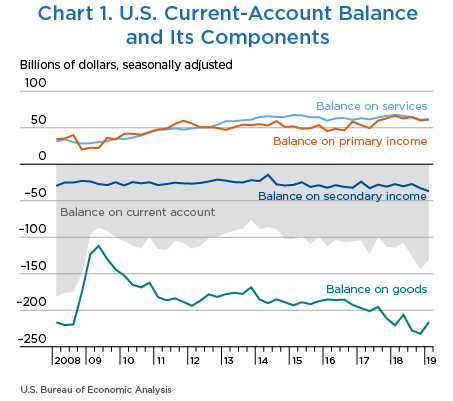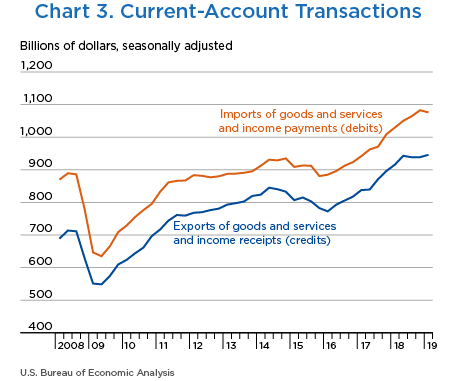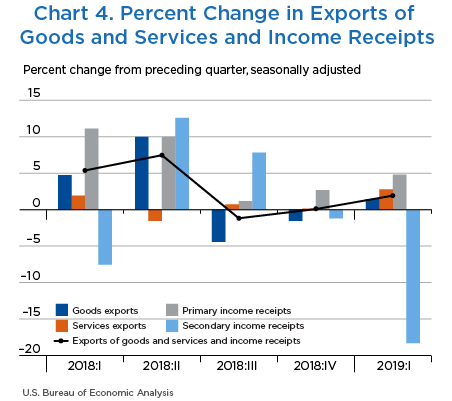U.S. International Transactions
First Quarter 2019
The U.S. current-account deficit—a net measure of transactions between the United States and the rest of the world in goods, services, primary income, and secondary income—decreased to $130.4 billion (preliminary) in the first quarter of 2019 from $143.9 billion (revised) in the fourth quarter of 2018 (chart 1 and table A). The deficit was 2.5 percent of current-dollar gross domestic product in the first quarter, down from 2.8 percent in the fourth quarter.
The $13.5 billion decrease in the current-account deficit mostly reflected a decrease in the deficit on goods that was partly offset by an increase in the deficit on secondary income.
Net U.S. borrowing measured by financial-account transactions was $37.8 billion in the first quarter, a decrease from net borrowing of $161.6 billion in the fourth quarter.
| 2018 | 2019 | Change 2018:IV to 2019:I | |||
|---|---|---|---|---|---|
| IIr | IIIr | IVr | Ip | ||
| Current account | |||||
| Exports of goods and services and income receipts (credits) | 942,932 | 938,438 | 938,689 | 945,865 | 7,176 |
| Exports of goods and services | 633,191 | 626,239 | 623,761 | 628,445 | 4,684 |
| Goods | 427,088 | 419,545 | 416,964 | 419,347 | 2,383 |
| Services | 206,103 | 206,694 | 206,797 | 209,098 | 2,301 |
| Primary income receipts | 272,285 | 273,570 | 276,483 | 281,792 | 5,309 |
| Secondary income (current transfer) receipts | 37,456 | 38,629 | 38,445 | 35,629 | −2,816 |
| Imports of goods and services and income payments (debits) | 1,050,243 | 1,064,177 | 1,082,616 | 1,076,268 | −6,348 |
| Imports of goods and services | 773,192 | 789,663 | 794,907 | 783,054 | −11,853 |
| Goods | 633,485 | 647,447 | 649,288 | 635,872 | −13,416 |
| Services | 139,707 | 142,216 | 145,620 | 147,182 | 1,562 |
| Primary income payments | 209,456 | 208,846 | 216,424 | 220,680 | 4,256 |
| Secondary income (current transfer) payments | 67,595 | 65,669 | 71,285 | 72,533 | 1,248 |
| Capital account | |||||
| Capital transfer receipts and other credits | 0 | 524 | 2,723 | 0 | −2,723 |
| Capital transfer payments and other debits | 5 | 3 | 2 | n.a. | n.a. |
| Financial account | |||||
| Net U.S. acquisition of financial assets excluding financial derivatives (net increase in assets / financial outflow (+)) | −243,468 | 81,893 | 147,259 | 151,569 | 4,310 |
| Direct investment assets | −110,279 | 52,845 | 25,696 | 59,529 | 33,833 |
| Portfolio investment assets | −17,660 | 83,415 | −22,210 | −59,743 | −37,533 |
| Other investment assets | −118,596 | −54,189 | 141,668 | 151,574 | 9,906 |
| Reserve assets | 3,068 | −177 | 2,105 | 208 | −1,897 |
| Net U.S. incurrence of liabilities excluding financial derivatives (net increase in liabilities / financial inflow (+)) | −126,092 | 127,770 | 286,247 | 167,902 | −118,345 |
| Direct investment liabilities | 16,603 | 126,925 | 52,720 | 105,453 | 52,733 |
| Portfolio investment liabilities | −12,609 | 12,274 | 14,884 | −7,740 | −22,624 |
| Other investment liabilities | −130,087 | −11,430 | 218,644 | 70,189 | −148,455 |
| Financial derivatives other than reserves, net transactions | −15,723 | −11,505 | −22,632 | −21,421 | 1,211 |
| Statistical discrepancy | |||||
| Statistical discrepancy1 | −25,783 | 67,837 | −20,414 | 92,648 | 113,062 |
| Balances | |||||
| Balance on current account | −107,311 | −125,739 | −143,927 | −130,403 | 13,524 |
| Balance on goods and services | −140,001 | −163,424 | −171,146 | −154,609 | 16,537 |
| Balance on goods | −206,396 | −227,902 | −232,323 | −216,525 | 15,798 |
| Balance on services | 66,396 | 64,478 | 61,177 | 61,916 | 739 |
| Balance on primary income | 62,829 | 64,724 | 60,059 | 61,111 | 1,052 |
| Balance on secondary income | −30,139 | −27,039 | −32,841 | −36,905 | −4,064 |
| Balance on capital account | −5 | 521 | 2,721 | 0 | −2,721 |
| Net lending (+) or net borrowing (-) from current- and capital-account transactions2 | −107,316 | −125,218 | −141,206 | −130,403 | 10,803 |
| Net lending (+) or net borrowing (-) from financial-account transactions3 | −133,098 | −57,381 | −161,621 | −37,754 | 123,867 |
- p
- Preliminary
- r
- Revised
- n.a.
- Not available
- The statistical discrepancy is the difference between net acquisition of financial assets and net incurrence of liabilities in the financial account (including financial derivatives) less the difference between total credits and total debits recorded in the current and capital accounts.
- Sum of current- and capital-account balances.
- Sum of net U.S. acquisition of financial assets and net transactions in financial derivatives less net U.S. incurrence of liabilities.
Note. The statistics are presented in table 1.2 on BEA’s website.
Current-account highlights
- The deficit on goods decreased $15.8 billion to $216.5 billion.
- The surplus on services increased $0.7 billion to $62.0 billion.
- The surplus on primary income increased $1.1 billion to $61.1 billion.
- The deficit on secondary income increased $4.1 billion to $36.9 billion.
Capital-account highlights
There were no capital-account transactions recorded in the first quarter, following receipts of $2.7 billion in the fourth quarter. The fourth-quarter transactions reflected receipts from foreign insurance companies for losses resulting from the wildfires in California. For information on transactions associated with natural disasters, see “What are the effects of hurricanes and other disasters on the international economic accounts?”
Financial-account highlights
- Net U.S. acquisition of financial assets excluding financial derivatives increased $4.3 billion in the first quarter to $151.6 billion (chart 2).
- Net U.S. incurrence of liabilities excluding financial derivatives decreased $118.3 billion in the first quarter to $167.9 billion.
- Transactions in financial derivatives other than reserves reflected first-quarter net borrowing of $21.4 billion.
Statistical discrepancy
The statistical discrepancy was $92.6 billion in the first quarter following a statistical discrepancy of −$20.4 billion in the fourth quarter.
Exports of goods and services and income receipts increased $7.2 billion, or 0.8 percent, in the first quarter to $945.9 billion (charts 3 and 4 and table B).
- Primary income receipts increased $5.3 billion, or 1.9 percent, to $281.8 billion, primarily reflecting increases in direct investment income and in other investment income. A decrease in portfolio investment income partly offset the increases. For more information on direct investment income, see “Effects of the 2017 Tax Cuts and Jobs Act on Components of the International Transactions Accounts.”
- Goods exports increased $2.4 billion, or 0.6 percent, to $419.3 billion, primarily reflecting increases in automotive vehicles, parts, and engines, mostly passenger cars, and in foods, feeds, and beverages, mainly soybeans. A decrease in industrial supplies and materials partly offset the increases.
- Services exports increased $2.3 billion, or 1.1 percent, to $209.1 billion, primarily reflecting an increase in travel (for all purposes including education), mostly personal travel.
- Secondary income receipts decreased $2.8 billion, or 7.3 percent, to $35.6 billion, reflecting decreases in both private and U.S. government transfers.
| 2018 | 2019 | Change 2018:IV to 2019:I | |||
|---|---|---|---|---|---|
| IIr | IIIr | IVr | Ip | ||
| Exports of goods and services and income receipts | 942,932 | 938,438 | 938,689 | 945,865 | 7,176 |
| Exports of goods | 427,088 | 419,545 | 416,964 | 419,347 | 2,383 |
| General merchandise | 421,770 | 413,442 | 412,683 | 414,659 | 1,976 |
| Foods, feeds, and beverages | 37,273 | 33,829 | 29,988 | 32,737 | 2,749 |
| Industrial supplies and materials | 136,177 | 135,990 | 136,077 | 130,938 | −5,139 |
| Energy products | 55,813 | 56,374 | 57,659 | 53,694 | −3,965 |
| Of which: Petroleum and products | 48,817 | 49,597 | 50,018 | 46,276 | −3,742 |
| Nonenergy products | 80,364 | 79,616 | 78,418 | 77,244 | −1,174 |
| Capital goods except automotive | 141,615 | 140,316 | 142,219 | 142,068 | −151 |
| Automotive vehicles, parts, and engines | 40,392 | 38,864 | 37,827 | 41,274 | 3,447 |
| Consumer goods except food and automotive | 51,264 | 51,121 | 51,917 | 52,963 | 1,046 |
| Other general merchandise | 15,049 | 13,323 | 14,655 | 14,678 | 23 |
| Net exports of goods under merchanting | 69 | 68 | 68 | 62 | −6 |
| Nonmonetary gold | 5,249 | 6,034 | 4,214 | 4,625 | 411 |
| Exports of services1 | 206,103 | 206,694 | 206,797 | 209,098 | 2,301 |
| Maintenance and repair services n.i.e. | 7,581 | 7,856 | 8,225 | 8,471 | 246 |
| Transport | 23,604 | 23,098 | 22,882 | 23,098 | 216 |
| Travel (for all purposes including education) | 53,964 | 53,013 | 53,297 | 54,678 | 1,381 |
| Business | 9,725 | 9,559 | 9,504 | 9,717 | 213 |
| Personal | 44,239 | 43,455 | 43,793 | 44,961 | 1,168 |
| Insurance services | 4,238 | 4,506 | 4,417 | 4,331 | −86 |
| Financial services | 28,298 | 28,003 | 27,854 | 28,208 | 354 |
| Charges for the use of intellectual property n.i.e. | 32,017 | 31,879 | 31,467 | 31,238 | −229 |
| Telecommunications, computer, and information services | 10,505 | 10,760 | 11,230 | 11,299 | 69 |
| Other business services | 40,360 | 42,319 | 42,074 | 42,428 | 354 |
| Government goods and services n.i.e. | 5,536 | 5,259 | 5,350 | 5,347 | −3 |
| Primary income receipts | 272,285 | 273,570 | 276,483 | 281,792 | 5,309 |
| Investment income | 270,623 | 271,881 | 274,786 | 280,085 | 5,299 |
| Direct investment income | 146,237 | 145,910 | 141,248 | 147,455 | 6,207 |
| Portfolio investment income | 101,758 | 102,991 | 107,568 | 104,204 | −3,364 |
| Income on equity and investment fund shares | 67,303 | 68,031 | 71,983 | 68,931 | −3,052 |
| Interest on debt securities | 34,455 | 34,961 | 35,586 | 35,274 | −312 |
| Other investment income | 22,580 | 22,750 | 25,783 | 28,194 | 2,411 |
| Reserve asset income | 47 | 230 | 187 | 231 | 44 |
| Compensation of employees | 1,663 | 1,689 | 1,697 | 1,707 | 10 |
| Secondary income (current transfer) receipts2 | 37,456 | 38,629 | 38,445 | 35,629 | −2,816 |
- p
- Preliminary
- r
- Revised
- n.i.e.
- Not included elsewhere
- See also Shari A. Allen, Alexis N. Grimm, and Christopher P. Steiner, “U.S. International Services: Trade in Services in 2017 and Services Supplied Through Affiliates in 2016,” Survey of Current Business 98 (October 2018).
- Secondary income receipts include U.S. government and private transfers, such as fines and penalties, withholding taxes, insurance-related transfers, and other current transfers.
Imports of goods and services and income payments decreased $6.3 billion, or 0.6 percent, in the first quarter to $1.08 trillion (charts 3 and 5 and table C).
- Goods imports decreased $13.4 billion, or 2.1 percent, to $635.9 billion, primarily reflecting a decrease in industrial supplies and materials, mainly petroleum and products.
- Primary income payments increased $4.3 billion, or 2.0 percent, to $220.7 billion, primarily reflecting an increase in direct investment income.
| 2018 | 2019 | Change 2018:IV to 2019:I | |||
|---|---|---|---|---|---|
| IIr | IIIr | IVr | Ip | ||
| Imports of goods and services and income payments | 1,050,243 | 1,064,177 | 1,082,616 | 1,076,268 | −6,348 |
| Imports of goods | 633,485 | 647,447 | 649,288 | 635,872 | −13,416 |
| General merchandise | 630,806 | 644,988 | 646,669 | 633,961 | −12,708 |
| Foods, feeds, and beverages | 37,088 | 37,105 | 37,358 | 37,488 | 130 |
| Industrial supplies and materials | 146,247 | 149,999 | 144,308 | 134,320 | −9,988 |
| Energy products | 64,469 | 67,746 | 60,804 | 54,796 | −6,008 |
| Of which: Petroleum and products | 61,074 | 64,211 | 56,190 | 50,470 | −5,720 |
| Nonenergy products | 81,778 | 82,253 | 83,504 | 79,524 | −3,980 |
| Capital goods except automotive | 174,076 | 176,328 | 175,102 | 172,303 | −2,799 |
| Automotive vehicles, parts, and engines | 90,780 | 93,978 | 96,013 | 95,529 | −484 |
| Consumer goods except food and automotive | 157,833 | 161,564 | 166,557 | 167,657 | 1,100 |
| Other general merchandise | 24,783 | 26,014 | 27,331 | 26,663 | −668 |
| Nonmonetary gold | 2,679 | 2,458 | 2,619 | 1,911 | −708 |
| Imports of services1 | 139,707 | 142,216 | 145,620 | 147,182 | 1,562 |
| Maintenance and repair services n.i.e. | 2,075 | 2,286 | 2,287 | 2,303 | 16 |
| Transport | 26,750 | 27,226 | 28,119 | 27,836 | −283 |
| Travel (for all purposes including education) | 35,426 | 36,148 | 37,364 | 38,020 | 656 |
| Business | 4,126 | 4,144 | 4,082 | 4,077 | −5 |
| Personal | 31,300 | 32,005 | 33,282 | 33,943 | 661 |
| Insurance services | 10,478 | 10,433 | 11,369 | 11,915 | 546 |
| Financial services | 7,872 | 7,776 | 7,932 | 8,058 | 126 |
| Charges for the use of intellectual property n.i.e. | 13,702 | 13,771 | 14,445 | 14,491 | 46 |
| Telecommunications, computer, and information services | 10,026 | 10,342 | 10,690 | 10,879 | 189 |
| Other business services | 27,643 | 28,426 | 27,635 | 27,800 | 165 |
| Government goods and services n.i.e. | 5,734 | 5,808 | 5,779 | 5,882 | 103 |
| Primary income payments | 209,456 | 208,846 | 216,424 | 220,680 | 4,256 |
| Investment income | 204,614 | 203,887 | 211,467 | 215,696 | 4,229 |
| Direct investment income | 64,252 | 61,217 | 62,648 | 65,885 | 3,237 |
| Portfolio investment income | 118,189 | 117,851 | 119,879 | 118,991 | −888 |
| Income on equity and investment fund shares | 40,112 | 39,186 | 40,874 | 40,296 | −578 |
| Interest on debt securities | 78,078 | 78,665 | 79,004 | 78,696 | −308 |
| Other investment income | 22,173 | 24,820 | 28,941 | 30,820 | 1,879 |
| Compensation of employees | 4,843 | 4,958 | 4,956 | 4,984 | 28 |
| Secondary income (current transfer) payments2 | 67,595 | 65,669 | 71,285 | 72,533 | 1,248 |
- p
- Preliminary
- r
- Revised
- n.i.e.
- Not included elsewhere
- See also Shari A. Allen, Alexis N. Grimm, and Christopher P. Steiner, “U.S. International Services: Trade in Services in 2017 and Services Supplied Through Affiliates in 2016,” Survey of Current Business 98 (October 2018).
- Secondary income payments include U.S. government and private transfers, such as U.S. government grants and pensions, fines and penalties, withholding taxes, personal transfers (remittances), insurance-related transfers, and other current transfers.
Acquisition of financial assets
- Net U.S. acquisition of direct investment assets increased $33.8 billion to $59.5 billion (chart 6 and table D). For more information on recent transactions in direct investment assets, see “Effects of the 2017 Tax Cuts and Jobs Act on Components of the International Transactions Accounts.”
- Net U.S. acquisition of other investment assets increased $9.9 billion to $151.6 billion, reflecting an increase in net U.S. provision of loans to foreign residents that was mostly offset by a decrease in net U.S. acquisition of currency and deposits.
- Net U.S. sales of portfolio investment assets increased $37.5 billion to $59.7 billion, reflecting net U.S. sales of foreign stocks following net U.S. purchases in the fourth quarter.
Incurrence of liabilities
- Net U.S. incurrence of other investment liabilities decreased $148.5 billion to $70.2 billion, mostly reflecting net foreign withdrawal of deposits in the United States following a net increase in deposits in the fourth quarter.
- Net foreign sales of U.S. portfolio investment liabilities were $7.7 billion following net foreign purchases of $14.9 billion in the fourth quarter, reflecting relatively large and nearly offsetting changes in U.S. stock and debt security transactions from the fourth to the first quarter.
- Net U.S. incurrence of direct investment liabilities increased $52.7 billion to $105.5 billion, primarily reflecting net U.S. incurrence of debt liabilities following net U.S. repayment in the fourth quarter.
| 2018 | 2019 | Change 2018:IV to 2019:I | |||
|---|---|---|---|---|---|
| IIr | IIIr | IVr | Ip | ||
| Net U.S. acquisition of financial assets excluding financial derivatives (net increase in assets / financial outflow (+)) | −243,468 | 81,893 | 147,259 | 151,569 | 4,310 |
| Direct investment assets | −110,279 | 52,845 | 25,696 | 59,529 | 33,833 |
| Equity | −85,734 | 56,999 | 19,875 | 49,685 | 29,810 |
| Equity other than reinvestment of earnings | −1,379 | 38,068 | 32,514 | 9,480 | −23,034 |
| Reinvestment of earnings | −84,355 | 18,931 | −12,639 | 40,204 | 52,843 |
| Debt instruments | −24,546 | −4,154 | 5,821 | 9,845 | 4,024 |
| Portfolio investment assets | −17,660 | 83,415 | −22,210 | −59,743 | −37,533 |
| Equity and investment fund shares | −67,646 | 31,868 | 31,754 | −94,908 | −126,662 |
| Debt securities | 49,986 | 51,547 | −53,964 | 35,165 | 89,129 |
| Short-term securities | 425 | 20,797 | −33,155 | 16,149 | 49,304 |
| Long-term corporate securities | 32,421 | 21,212 | −14,190 | 11,148 | 25,338 |
| Other long-term securities | 17,140 | 9,538 | −6,619 | 7,868 | 14,487 |
| Other investment assets | −118,596 | −54,189 | 141,668 | 151,574 | 9,906 |
| Currency and deposits | −23,426 | −22,998 | 68,005 | 20,928 | −47,077 |
| Loans | −96,816 | −29,151 | 71,630 | 132,567 | 60,937 |
| Trade credit and advances | 1,645 | −2,040 | 2,033 | −1,921 | −3,954 |
| Reserve assets | 3,068 | −177 | 2,105 | 208 | −1,897 |
| Monetary gold | 0 | 0 | 0 | 0 | 0 |
| Special drawing rights | 33 | 43 | 47 | 57 | 10 |
| Reserve position in the International Monetary Fund | 3,136 | −288 | 2,049 | 114 | −1,935 |
| Other reserve assets | −101 | 68 | 9 | 38 | 29 |
| Net U.S. incurrence of liabilities excluding financial derivatives (net increase in liabilities / financial inflow (+)) | −126,092 | 127,770 | 286,247 | 167,902 | −118,345 |
| Direct investment liabilities | 16,603 | 126,925 | 52,720 | 105,453 | 52,733 |
| Equity | 51,313 | 116,455 | 117,667 | 92,463 | −25,204 |
| Equity other than reinvestment of earnings | 11,436 | 80,043 | 80,200 | 48,998 | −31,202 |
| Reinvestment of earnings | 39,877 | 36,412 | 37,468 | 43,465 | 5,997 |
| Debt instruments | −34,710 | 10,470 | −64,948 | 12,990 | 77,938 |
| Portfolio investment liabilities | −12,609 | 12,274 | 14,884 | −7,740 | −22,624 |
| Equity and investment fund shares | −38,297 | −90,582 | 117,758 | −206,073 | −323,831 |
| Debt securities | 25,689 | 102,856 | −102,874 | 198,334 | 301,208 |
| Short term | 37,032 | −53,228 | 13,045 | 22,022 | 8,977 |
| Treasury bills and certificates | 33,597 | −35,170 | 30,182 | 18,041 | −12,141 |
| Federally sponsored agency securities | −693 | −6,121 | −2,082 | 3,901 | 5,983 |
| Other short-term securities | 4,128 | −11,937 | −15,055 | 80 | 15,135 |
| Long term | −11,343 | 156,085 | −115,919 | 176,312 | 292,231 |
| Treasury bonds and notes | −19,373 | 96,764 | −83,006 | 126,275 | 209,281 |
| Federally sponsored agency securities | 20,761 | 19,460 | 16,295 | 21,438 | 5,143 |
| Corporate bonds and notes | −14,115 | 39,939 | −47,683 | 27,560 | 75,243 |
| Other | 1,384 | −78 | −1,525 | 1,039 | 2,564 |
| Other investment liabilities | −130,087 | −11,430 | 218,644 | 70,189 | −148,455 |
| Currency (short term) | 19,391 | 19,606 | 9,364 | 5,249 | −4,115 |
| Deposits | −76,087 | −26,639 | 95,229 | −36,864 | −132,093 |
| Loans | −78,009 | −6,605 | 114,887 | 95,259 | −19,628 |
| Trade credit and advances | 4,619 | 2,208 | −836 | 6,545 | 7,381 |
| Special drawing rights allocations | 0 | 0 | 0 | 0 | 0 |
- p
- Preliminary
- r
- Revised
In the international transactions accounts, income on equity, or earnings, of foreign affiliates of U.S. multinational enterprises consists of a portion that is repatriated to the parent company in the United States in the form of dividends and a portion that is reinvested in foreign affiliates. In response to the 2017 Tax Cuts and Jobs Act, which generally eliminated taxes on repatriated earnings, some U.S. multinational enterprises repatriated accumulated prior earnings of their foreign affiliates. In the first, second, and fourth quarters of 2018, the repatriation of dividends exceeded current-period earnings, resulting in negative values being recorded for reinvested earnings. In primary income in the first quarter of 2019, dividends were $100.2 billion, while reinvested earnings were $40.2 billion (chart 7 and table E). The reinvested earnings are also reflected in the net acquisition of direct investment assets in the financial account (table D).
| 2017 | 2018 | 2019 | |||||||
|---|---|---|---|---|---|---|---|---|---|
| Ir | IIr | IIIr | IVr | Ir | IIr | IIIr | IVr | Ip | |
| Direct investment earnings | 114,743 | 115,429 | 122,185 | 130,702 | 134,297 | 139,437 | 139,162 | 133,966 | 140,450 |
| Dividends | 38,215 | 34,881 | 55,110 | 26,874 | 285,885 | 223,792 | 120,231 | 146,605 | 100,246 |
| Reinvested earnings | 76,528 | 80,548 | 67,075 | 103,828 | −151,588 | −84,355 | 18,931 | −12,639 | 40,204 |
- p
- Preliminary
- r
- Revised
The U.S. international transactions statistics for the first quarter of 2014 through the fourth quarter of 2018 have been updated to incorporate newly available and revised source data and updated seasonal factors (table F).
For more information, see Eric Bryda, C. Omar Kebbeh, and Ted Peck, “Annual Update of the U.S. International Transactions Accounts,” in this issue of the Survey of Current Business.
| Preliminary estimates | Revised estimates | |
|---|---|---|
| Balance on current account | −134,377 | −143,927 |
| Balance on goods | −233,053 | −232,323 |
| Balance on services | 66,090 | 61,177 |
| Balance on primary income | 60,435 | 60,059 |
| Balance on secondary income (current transfers) | −27,849 | −32,841 |
| Balance on capital account | 8,856 | 2,721 |
| Net lending or borrowing from financial-account transactions | −168,310 | −161,621 |
| Net U.S. acquisition of financial assets | 171,967 | 147,259 |
| Net U.S. incurrence of liabilities | 320,216 | 286,247 |
| Financial derivatives other than reserves, net transactions | −20,061 | −22,632 |






